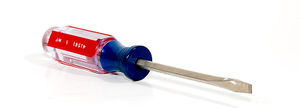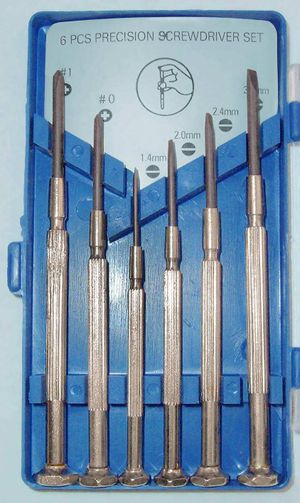Difference between revisions of "Screwdriver"
(far more) |
(→Screwdriver forms: fix pic) |
||
| Line 4: | Line 4: | ||
[[image:ElectricScrewdriver.jpg|thumb|Low power electric screwdriver]] | [[image:ElectricScrewdriver.jpg|thumb|Low power electric screwdriver]] | ||
[[image:Spiral-screwdriver.jpg|thumb|Push drive Yankee]] | [[image:Spiral-screwdriver.jpg|thumb|Push drive Yankee]] | ||
| − | [[image: | + | [[image:Jeweller's-screwdriver-set.jpg|thumb|Jeweller's screwdrivers]] |
Screwdrivers come in jeweller's, stubby, small, medium, large and oh my god what are you going to do with that sizes. | Screwdrivers come in jeweller's, stubby, small, medium, large and oh my god what are you going to do with that sizes. | ||
| Line 25: | Line 25: | ||
[[Electric screwdrivers]] are covered in their own article. | [[Electric screwdrivers]] are covered in their own article. | ||
| − | |||
==Bits== | ==Bits== | ||
Revision as of 01:51, 23 April 2008
Screwdriver forms
Screwdrivers come in jeweller's, stubby, small, medium, large and oh my god what are you going to do with that sizes.
Screwdrivers can be traditional one piece tools, or hold replaceable hex bits.
Screwdrivers can be manual or electrically powered. There are also push powered spiral screwdrivers such as the Yankee, but these are rarely used in DIY today.
They come in 90 degree cranked (bent) form for where access is difficult.
They come in pound-through form where hammering is needed. These have the metal shank continuing all the way through the handle so it can be hit directly.
When access is too tight to use a cranked or stubby driver, a short bit plus pliers may work.
Extra large screwdrivers are quite useful, but frequently attract rude comments and strange stares on site. They position the hands well away from cramped corners and abrasive walls, they allow driving without needing to get close to the workpiece, and they sometimes allow a better working position, making application of force easier. In cramped conditions they can also allow workmates to pass between you and the screws while you're working. They are also good when one is forced to work in an awkward position, as a given amount of hand movement or wobble has much less effect on screwdriver angle.
Impact drivers are a special type of screwdriver that turns when hit with a hammer. These give the ultimate in screwing and unscrewing power. The name 'Impact driver' is also used for power tools that do a similar but not identical job.
Both screwdrivers and bits are available with diamond coating. I hear they make driving easier by gripping well, as long as they're not abused.
Electric screwdrivers are covered in their own article.
Bits
1/4" hex screwdriving bits come in short 1", medium 2" and long 6" forms.
Hex bits are covered fully in their own article here.
Screwdriver materials
Blade
Screwdrivers are made from either chrome vanadium steel or carbon steel.
Chrome vanadium
This is the softer of the two, and the bits are liable to become damaged over time. Most screwdrivers today are chrome van.
Carbon steel
Harder, lasts longer, and performs better. However it has its downsides.
- It rusts readily, hence its often chrome coated. Chrome is a relatively slippery coating, and not wanted for screwdriving.
- Being harder, carbon steel can eventually break rather than chew up. Harder steel is also not so tolerant of misuse, eg use as a mini prybar.
Most screwdrivers today are chrome vanadium, perhaps because minimising failures is more useful to the manufacturer than maximising performance. If you want the better performance of correctly hardened and tempered carbon steel, Draper, Tough-Tools and Stanley still sell them.
Handle
Handles come in wood, plastic or rubber. Wood and plastic handles have little to choose between them, except that plastic is available in a wider range of shapes. Rubber handles help maximise grip.
There are many handle shapes available, with large oval cabinet maker handles being one of the more comfortable.
Most significant is the size of the handle. The bigger the handle width, the more leverage advantage is obtained, making application of high forces easier. Switching from a small to a big handle can make a challenging screw easy.
For electrical connections high forces are not normally needed, and slender handles enable quicker spinning of the tool.
Electrical Screwdrivers
Shank
Electrical Screwdrivers with a fully sleeved shank are available. These reduce the remote risk of all the following happening at once: the wiring being live, touching the screwdriver shank during work, and being sufficiently well earthed for serious harm to occur.
Good quality drivers are tested to 10kV. Cheap imitations may be rated 1kV and not tested at all. The latter are still an improvement over bare shanks, although the safety advantage of an insulated shank is tiny.
The exception is with live working, where an insulated shank is a very good idea. However most DIYers don't work live.
Bit
The driving bit of slotted electrical screwdrivers is a little differently shaped. Whereas traditional screwdrivers widen where the metal is flattened, electrical screwdrivers don't, making them better suited to work in narrow access holes.
Junk screwdrivers
These are generally small with narrow plastic handles, giving poor driving force and being hard on hands. The worst ones have a soft steel bit, making them bend readily. Occasionally a tiny one can get in places others won't. Cross head types may fail to fit the screwhead.
Electronic adjustment
Jeweller's screwdrivers are sometimes used to adjust settings in electronic equipment. Metal drivers affect the tuning of rf circuitry, making proper adjustment with these very difficult. All-plastic tools are available for this, making the task non-problematic. Plastic tools are no use for screwdriving.


